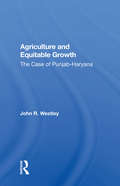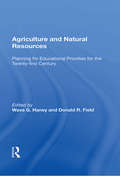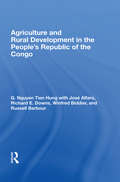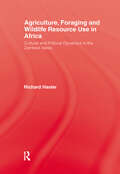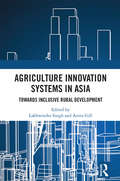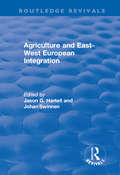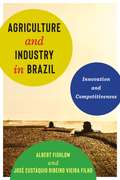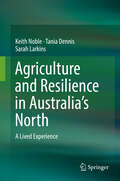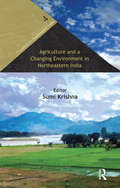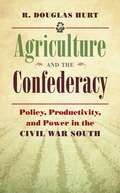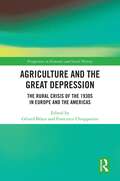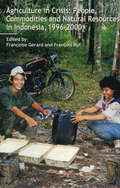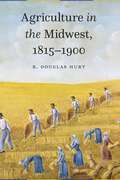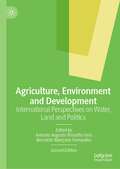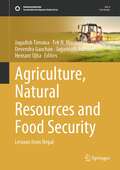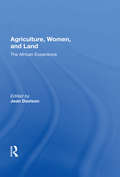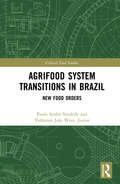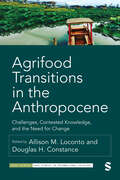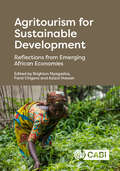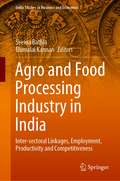- Table View
- List View
Agriculture And Equitable Growth: The Case Of Punjab-haryana
by John R. WestleyThis book aims to examine how the pattern of growth in the agricultural sectors has contributed to equitable growth and to assess the relevance of the relationship between agriculture and equitable growth in Punjab-Haryana for other states in India and for other low-income countries.
Agriculture And Natural Resources: Planning For Educational Priorities For The Twenty-first Century
by Donald R. Field Wava G. HaneyThis book identifies issues and trends in agriculture, natural resources, and rural communities in the context of topical strategic planning. It portrays both the process of planning and the substantive content driving a planning process. .
Agriculture And Rural Development In The People's Republic Of The Congo
by G. Nguyen HungThis comprehensive study outlines the current transformation in agriculture and its effect on the demography, development, and economy of the People’s Republic of the Congo. G. Nguyen Tien Hung analyzes fundamental structural changes within the economy and the impact of the application of the Marxist model of development upon the performance and gr
Agriculture Foraging & Wildlife
by HaslerFirst Published in 1996. Routledge is an imprint of Taylor & Francis, an informa company.
Agriculture Geography First Semester FYBA, B.COM, B.SC New NEP Syllabus - SPPU
by Dr Jyotiram C. More Prof. Harishchandra S. Timbole Dr Ganesh Madhukar DhawaleThe book titled "Agriculture Geography" provides a comprehensive overview of agricultural geography, its principles, and its importance. It begins with the definition and scope of agricultural geography, examining the spatial relationships between agriculture and human activities. The text discusses the various types of agriculture, including subsistence, commercial, and mixed farming, as well as modern trends like smart and natural farming. It explores the physical and economic factors influencing Indian agriculture, highlights the historical and geographical transformations in agricultural practices, and addresses the impact of agricultural revolutions like the Green, White, and Blue Revolutions. The book also covers government policies, technological advancements, and new perspectives aimed at achieving sustainable agriculture, ensuring food security, and improving farmer incomes. Designed as a textbook for students, it combines theoretical knowledge with practical insights, supported by exercises and examples for academic and competitive examinations.
Agriculture In Third Wrl/h
by W. B. Morgan... we do not yet seem to have realised that the exchange of products between countries in one part of the world but at different stages of development is no less natural, and no less profitable for the various nations, than the exchange of products which differ because they grow in different climates' (Thiinen-Hall, xg66, p. 194). There have been few attempts to study agriculture within a spatial framework, notwithstanding the quintessential importance of land as a production factor. Land is most often treated as generalized environment although it could also be considered as social and economic space-social because even the most crowded of farming communities has much greater distance between its basic social units than exist within an urban-industrial agglomeration, and economic because distances to markets, to factor sources and to information must be overcome and frequently vary by type of market, factor and information source. Modem agricultural geography has been largely preoccupied with the development of techniques and with classification, often as ends in thexnselves, or with a geographical element consisting mainly of some general locational reference or regional description. Rarely has there been an attempt to identify a spatial structure associated with some particular agricultural enterprise* or practice.
Agriculture Innovation Systems in Asia: Towards Inclusive Rural Development
by Lakhwinder Singh Anita GillThis book looks at agricultural systems and rural economies in Asia through the prism of alternative innovation systems, alternative public policy and institutional changes. The massive shifts within the agricultural economy in Asia, geared towards increasing production, has had a direct effect on the livelihood of a large mass of people in rural societies, causing financial and social distress. This book explores a wide range of solutions, such as the role of education, improving technical skills and human capital, along with interactive learning in R&D, harnessing ICTs and institutional innovations, to see how these problems can be alleviated. The volume looks at how these methods can help formulate alternative ways to build sustainable and inclusive agricultural societies, ensure food security, sustainable growth and agricultural productivity. This book, rich in theoretical and empirical matter, will be useful for academics and researchers interested in agricultural innovation, development studies and agricultural economics. It will also be of interest to policymakers and thinktanks working towards inclusive social development and sustainability in Asia and the Indian subcontinent.
Agriculture and East-west European Integration
by JASON G. HARTELL, JOHAN F.M. SWINNENThis title was first published in 2000: This volume analyzes key issues of the process of integrating Central and Eastern European countries with the European Union related to agriculture. The issues include the comparative advantage of CEEC agriculture and its development under various accession policy scenarios; the likely policy developments in both the CEECs and the EU, based on economic, social and political economy considerations; the expected economic impacts and adjustment costs for the agro-food sector under various policy outcomes; the most important constraints for integration including policy convergence issues and internal constraints; and how integration will potentially affect trade and labour flows in the Union. The country combines detailed country-specific and region-wide empirical and theoretical analysis.
Agriculture and Economic Development in East Asia: From Growth to Protectionism in Japan, Korea and Taiwan (Esrc Pacific Asia Ser.)
by Penelope Francks Joanna Boestel Choo Hyop KimA comparative study which describes and analyses the contribution of agriculture to the economies of East Asia. Until now, little attention has been paid to the agricultural sector which actually underpins industrial and commercial development. Recently, this sector has become the focus of increasingly bitter economic disputes, especially over protection and the use of import tariffs. A comparative framework is used, employing case studies from Japan, Taiwan and South Korea to highlight both the common characteristics of agriculture's role in East Asian development, and features particular to the political economy of agriculture in each country.
Agriculture and Industry in Brazil: Innovation and Competitiveness
by Albert Fishlow José Eustáquio Vieira FilhoAgriculture and Industry in Brazil is a study of the economics of Brazilian agriculture and industry, with a special focus on the importance of innovation to productivity growth. Albert Fishlow and José Eustáquio Ribeiro Vieira Filho examine technological change in Brazil, highlighting the role of public policy in building institutions and creating an innovation-oriented environment.Fishlow and Vieira Filho tackle the theme of innovation from various angles. They contrast the relationship between state involvement and the private sector in key parts of the Brazilian economy and compare agricultural expansion with growth in the oil and aviation sectors. Fishlow and Vieira Filho argue that modern agriculture is a knowledge-intensive industry and its success in Brazil stems from public institution building. They demonstrate how research has played a key role in productivity growth, showing how prudent innovation policies can leverage knowledge not only within a particular company but also across whole sectors of the economy. The book discusses whether and how Brazil can serve as a model for other middle-income countries eager to achieve higher growth and a more egalitarian distribution of income. An important contribution to comparative, international, and development economics, Agriculture and Industry in Brazil shows how the public success in agriculture became a prototype for advance elsewhere.
Agriculture and Resilience in Australia’s North: A Lived Experience
by Keith Noble Tania Dennis Sarah LarkinsThis book examines the mechanisms and strategies farmers in North Australia adopt to manage the setbacks and challenges they face. This social research is based on farmers’ experiences, but also draws on the author’s own experience after his tropical fruit farm was destroyed by two Category 5 cyclones in five years.Through historical analysis, the book compares historic and contemporary aspirations for northern development, and discusses the influence of the built environment on individuals as well as access to health and other social services.Exploring the implications of individual resilience strategies for policy development within the broader context of northern development and evolving environmental governance, the book also highlights the fact that this is occurring in a new geological epoch – the Anthropocene.The book will provide a unique perspective and understanding to government, individuals and industries interested in northern Australia and its relationship to the world
Agriculture and a Changing Environment in Northeastern India (Transition In Northeastern India Ser.)
by Sumi KrishnaIndia’s northeastern region, forged by a unique geological history and peopled by several waves of migration, is extraordinarily complex. Farming systems in the hills and the riverine plains are embedded in a heterogeneous environment, comprising forests, wetlands and fields, shaped over centuries by nature and people. Today, the environment and economy are undergoing rapid transformation, affecting peoples’ lives, livelihoods and methods of food production.The essays in this volume bring a multi-disciplinary perspective to critical aspects of the process of agricultural change, examine the gender dimensions of agriculture, and explore initiatives for sustainable livelihood and ecological conservation. Part I analyses the impact of policies and people’s own aspirations on the closely-intertwined ecology and economy of the region. Part II discusses the gender dynamics of farming, forestry and biodiversity in a socio-cultural context where women are primarily responsible for food production. Part III highlights some alternative farming interventions and community-based efforts for environmental conservation, sustainable resource management and improved livelihoods.This book will be useful to scholars and students of agriculture, economics, development, environment and gender studies, and to those involved in policy analysis, natural resource management and community organisation, as also general readers interested in India’s northeastern region.
Agriculture and the Confederacy
by R. Douglas HurtIn this comprehensive history, R. Douglas Hurt traces the decline and fall of agriculture in the Confederate States of America. The backbone of the southern economy, agriculture was a source of power that southerners believed would ensure their independence. But, season by season and year by year, Hurt convincingly shows how the disintegration of southern agriculture led to the decline of the Confederacy's military, economic, and political power. He examines regional variations in the Eastern and Western Confederacy, linking the fates of individual crops and different modes of farming and planting to the wider story. After a dismal harvest in late 1864, southerners--faced with hunger and privation throughout the region--ransacked farms in the Shenandoah Valley and pillaged plantations in the Carolinas and the Mississippi Delta, they finally realized that their agricultural power, and their government itself, had failed. Hurt shows how this ultimate lost harvest had repercussions that lasted well beyond the end of the Civil War.Assessing agriculture in its economic, political, social, and environmental contexts, Hurt sheds new light on the fate of the Confederacy from the optimism of secession to the reality of collapse.
Agriculture and the Great Depression: The Rural Crisis of the 1930s in Europe and the Americas (Perspectives in Economic and Social History)
by Gérard Béaur Francesco ChiapparinoWhat role did the agricultural sector play in the economic crash of 1929? Taking evidence from country cases across Europe and the Americas, this edited volume explores short-, medium- and long-term perspectives on the primary sector. The monograph brings together the voices of an international panel of contributors who examine issues such as falling prices, industrial production, unemployment and the stagnation of aggregate demand. Together, they frame the interwar period as a pivotal turning point in the decline of subsistence agriculture and the growth of agricultural subsidies, which remain a key policy tool in many economies today. This illuminating book will be of interest to advanced students and researchers in economic history, agricultural history, globalization, and economic development.
Agriculture in Crisis: People, Commodities and Natural Resources in Indonesia 1996-2001
by Francoise Gerard Francois RufIndonesia's monetary and political crisis is examined here in relation to its impact on Indonesia's agricultural sector. The twelve essays that comprise this volume take a micro-economic approach and analysis relies on observed facts and first-hand data collected both before and after the country's crisis. This is a lively, well illustrated and instructive book.
Agriculture in the Midwest, 1815–1900
by Prof. R. Douglas HurtAfter the War of 1812 and the removal of the region&’s Indigenous peoples, the American Midwest became a paradoxical land for settlers. Even as many settlers found that the region provided the bountiful life of their dreams, others found disappointment, even failure—and still others suffered social and racial prejudice. In this broad and authoritative survey of midwestern agriculture from the War of 1812 to the turn of the twentieth century, R. Douglas Hurt contends that this region proved to be the country&’s garden spot and the nation&’s heart of agricultural production. During these eighty-five years the region transformed from a sparsely settled area to the home of large industrial and commercial cities, including Chicago, Milwaukee, Cleveland, and Detroit. Still, it remained primarily an agricultural region that promised a better life for many of the people who acquired land, raised crops and livestock, provided for their families, adopted new technologies, and sought political reform to benefit their economic interests. Focusing on the history of midwestern agriculture during wartime, utopian isolation, and colonization as well as political unrest, Hurt contextualizes myriad facets of the region&’s past to show how agricultural life developed for midwestern farmers—and to reflect on what that meant for the region and nation.
Agriculture, Environment and Development: International Perspectives on Water, Land and Politics
by Antonio Augusto Rossotto Ioris Bernardo Mançano FernandesThe Second Edition of this book is completely revised and updated throughout providing an overview of current challenges faced within the area of Agri-food in relation to policymaking, ecological conservation and socio-environmental justice. Including a range of new chapters, the book explores some of the conceptual and analytical gaps that are presented by current approaches to this topic. The series of interconnected chapters offers a critical reinterpretation of the tensions associated with the failures of mainstream regulatory regimes, land and resource grabbing, and the impacts of global agri-food chains at local, regional and inter-sectoral scales. The book also examines past legacies and emerging challenges associated with agriculture modernisation, politico-spatial disputes, climate change, social movements, gender, ethnicity and education. It likewise addresses the transformative potential of different combinations of biophysical, socio-technical and socio-spatial practices of food sovereignty.
Agriculture, Natural Resources and Food Security: Lessons from Nepal (Sustainable Development Goals Series)
by Jagadish Timsina Tek N. Maraseni Devendra Gauchan Jagannath Adhikari Hemant OhjaThis book explains how a former net food exporting Nepal has become a net food importing country due to a lack of an integrated system-wide approach to planning and governance of agriculture and natural resources. It demonstrates how various components of the food system, such as agronomy, agrobiodiversity, plant health, post-harvest management, livestock and fisheries, and socio-economics including marketing and trade, have been managed in sectoral silos, crippling the very foundations of food systems innovations. The book also explores ways to tackle climate change impacts while considering gender, social equity, conservation agriculture practices, and crop modeling as cross-cutting themes. This book utilizes Nepal as a case study in relation to wider questions of food security and livelihoods facing South Asia and synthesizes lessons that are relevant to the Global South where countries are struggling to harmonize and integrate natural resources management for sustainable and effective food security outcomes. As such, it significantly contributes to the knowledge toward achieving various United Nations Sustainable Development Goals.
Agriculture, Poverty and Reform in Iran (Routledge Library Editions: Iran)
by Mohammad Javad AmadAs in many developing countries, the prospects for land reform in Iran seemed promising. It was expected to improve rural poverty and stimulate agricultural development by replacing the traditional landlord-peasant system with more peasant-biased, modern farming. This book assesses the economic consequences of land reform, focusing particularly on its effect on the living standards of the rural poor. Amid describes a ‘biomodal’ system of large and small farms that emerged after the reform. Large farms, with government support, modernized and grew more profitable cash crops, whereas small farms found difficulty in obtaining credit and continued to rely on traditional techniques and staple food crops. Land reform was not, the author argues a success for the majority of the Iranian rural population who experienced virtually no improvement in living standards and a growth of rural inequality as a result.
Agriculture, Women, And Land: The African Experience
by Jean DavisonThis book examines gender relations to land relations that are crucial to formulating policies through which African women's food producing capabilities can be advanced. It addresses the need to document historical changes in land tenure practices that have influenced women's household production.
Agrifood System Transitions in Brazil: New Food Orders (Critical Food Studies)
by Paulo André Niederle Valdemar João Wesz JuniorThis book explores the agrifood system transitions in Brazil to provide a new understanding of the trajectory of agriculture and rural development in this country. It accentuates the increasing diversifi cation and hybridization of food production and consumption practices throughout history. With a framework that combines convention theory, neoinstitutional approaches and practice theory, this book suggests the concept of “food orders” which represents different arrangements of practices, institutions and sociotechnical artifacts. By exploring the interrelations between these elements, the book looks at six different food orders: industrial, commercial, domestic, aesthetic, civic and fi nancial, in tandem with examples of practices, sectors and territories to understand the dynamics of each one. This aids in understanding the main tendencies of the agrifood sector in such a vast country that, being a major player in global food markets, also affect production and consumption dynamics in several other countries. Besides, this book also seeks to comprehend the current institutional changes in Brazil that may be critical to interpret the global dissemination of populist and autocratic governments. Offering key insights into the contemporary sociology of agriculture and food, this book demonstrates how strengthening democracy and supporting the organization of civil society are major challenges when we think about transition for sustainable food systems.
Agrifood Transitions in the Anthropocene: Challenges, Contested Knowledge, and the Need for Change (SAGE Studies in International Sociology)
by Douglas H. Constance Allison M. LocontoThe greatest challenges of the twenty-first century stem from the fact that we are now living in a new epoch: the Anthropocene. The human footprint on the planet can no longer be denied. One of the greatest and most essential human innovations, agriculture, is being increasingly recognised as a leading contributor to climate change. According to global governance bodies, the world will need to feed a predicted nine billion people by 2050. However, in this Anthropocene, we must address the environmental inequalities in how these people will be fed. This book explores our current societal struggles to transition towards more sustainable agrifood systems. It suggests that debates around sustainable agriculture must be social as well as technical, exploring the growth of social movements campaigning for more democratic food systems. However, as each chapter demonstrates, both the problems and the solutions in sustainable agriculture are highly contested. Using the term ′agrifood′ to capture the nexus between research, governance and the environment knowledge-environment-governance, this book provides an in-depth and wide-ranging account of current research around agricultural production and food consumption. The book introduces the Anthropocene along with the fundamental question that it poses about human-nature interactions. It outlines the core concerns related to agriculture and food and the debates around the need for agrifood system transitions. Each chapter investigates controversies in the field through case studies. These contributions offer a call for sociologists of agriculture and food to engage with the controversies unfolding in the Anthropocene.
Agrifood Transitions in the Anthropocene: Challenges, Contested Knowledge, and the Need for Change (SAGE Studies in International Sociology)
by Douglas H. Constance Allison M. LocontoThe greatest challenges of the twenty-first century stem from the fact that we are now living in a new epoch: the Anthropocene. The human footprint on the planet can no longer be denied. One of the greatest and most essential human innovations, agriculture, is being increasingly recognised as a leading contributor to climate change. According to global governance bodies, the world will need to feed a predicted nine billion people by 2050. However, in this Anthropocene, we must address the environmental inequalities in how these people will be fed. This book explores our current societal struggles to transition towards more sustainable agrifood systems. It suggests that debates around sustainable agriculture must be social as well as technical, exploring the growth of social movements campaigning for more democratic food systems. However, as each chapter demonstrates, both the problems and the solutions in sustainable agriculture are highly contested. Using the term ′agrifood′ to capture the nexus between research, governance and the environment knowledge-environment-governance, this book provides an in-depth and wide-ranging account of current research around agricultural production and food consumption. The book introduces the Anthropocene along with the fundamental question that it poses about human-nature interactions. It outlines the core concerns related to agriculture and food and the debates around the need for agrifood system transitions. Each chapter investigates controversies in the field through case studies. These contributions offer a call for sociologists of agriculture and food to engage with the controversies unfolding in the Anthropocene.
Agritourism for Sustainable Development: Reflections from Emerging African Economies
by Dumisani Rumbidzai Muzira Ernest Mugoni Jabulani Garwi Admire Mthombeni Bronson Mutanda Collen Sabao Dzingai Kennedy Nyahunzvi Edward Chinongwa Enard Mutenheri Felix Chari Geoffrey Korir Gilda Eyang Gracious Mutipforo Hellen Amunga Judith Moyo Katsande Chipo Martin Dzapasi Noreen Watyoka Nyasha Tendai Makiwa Lucyna Przezborska-Skobiej Komborerai Wilfred Chikwape Obert Sifile Ranganayi Njodzi Raymond Mapuranga Regis Muchowe Samulo Mutale Sharon Chisango Shingirai Siziba Solomon Marime Tendai Shelton Muwani Tichakunda Valentine Chabata Willard Muntanga Yeukayi Dzapasi Zibanai ZhouThrough the lens of African emerging economies, this text examines empirical studies and the related practices of agritourism. By looking at tourism innovation, entrepreneurship ethics and responsibility of public and private organizational stakeholders, the text promotes an understanding of how radical novel sustainable agritourism might be implemented to help society's living become more sustainable with low usage of material resources, low energy and environmental cost. Informed by the 2030 Agenda for Sustainable Development and Sustainable Development Goals (SDGs) framework, which emphasize the fostering of novel sustainable agritourism, the book includes: methodologies, theory, reviews, primary research findings and practice topics such as start-ups, legal aspects, CSR and digital technologies techniques and tools with global application The book will be of interest to academics and postgraduate students interested in the challenges of sustainable agritourism and African emerging economies.
Agro and Food Processing Industry in India: Inter-sectoral Linkages, Employment, Productivity and Competitiveness (India Studies in Business and Economics)
by Seema Bathla Elumalai KannanThis book provides different facets of India's agro and food processing industry in both organised and unorganised segments. It brings forth the topical issues having potential to accelerate the pace of growth in its employment, investment and productivity and strive for improving the global competitiveness. Using advanced quantitative techniques, it brings new evidences on inter-sectoral (agriculture-industry-services) employment and production linkages, contractual arrangements through Farmer Producer Companies, and subcontracting in the processed food sector. It also throws light on India's comparative advantage in export of primary and processed food products.With rising per capita income, urbanisation, and changing food habits of people, India is increasingly striving to improve productivity and competitiveness in agriculture and manufacturing. A concerted policy focus to accelerate private investment in food processing, largely viewed as a sunrise industry, is expected to contribute to large scale job creation and external trade not only in the manufacturing but also in the agricultural sector. Keeping this in mind, considerable insights are featured in the book at the industry and firm levels due to a significant bearing of technological, tariffs and non-tariff barriers and labour regulations on their trade intensity, employment and efficiency. Containing perspectives from the top agriculture and industry economists in the country, the book will be very useful to researchers, academicians, trade analysts and policy makers.
